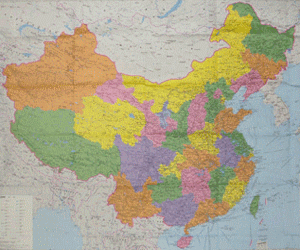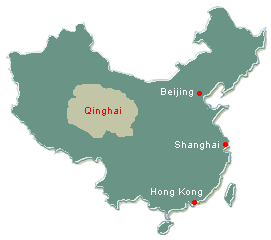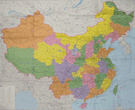|
|
|
Geography of Qinghai Province |
|
Situated in the northeast of the Qinghai-Tibet plateau covers an area of
720,000 sq. km, Flanked by two big mountain ranges—Qilian in the north,
Tanggula in the south, 4/5 of this highland averages 3,000 meters above
sea level. In its middle, stands another big mountain spur----the
Kunlun. 95% of province is pastureland. What makes the physical feature
of the region unique is that two major Chinese waters, the Yangtze and
the Yellow Rivers all originate here: one from the southwest slop of
main peak of Tanggula; one from northern slope of Bayanhar. This feature
has earned the province a name as the source of the rivers. Clad in snow
in winter and cool in summer and with 17.2
ºC (62.96
ºF) as its average
monthly temperature in July, the area is an ideal summer resort. The
province has a sparse population, 5.92 million (2023) in total. The inhabitants
are made up of different ethnic group: the
Han, the
Tibetan, The
Hui,
The
Monoglian, the
Tu and the
Salar.
|
|
|
Climate of Qinghai Province |
|
|
|
|
Brief History of Qinghai Province |
|
The Qinghai province has a long history. A military fortress known as
Xipingting was built the former site of the city Xining by a hero
general Huo Qubing in the second year of reign of Wu Di of Han
Dynasty (206 B.C. - 220), dating from 2100 years ago. During this period, officials
from central government came and got settle down in the region to
exercise the rule of Han Court. In the 4th year A.D, the local
government was officially founded at the prefecture level, Late, in
Sui Dynasty (581- 608) two more added. The city Xining began appear in Ming
Dynasty (1368-1644), meanwhile the judicial system was reinforced. With
the development of the region, trade expanded dramatically. The capital
city
of Qinghai -
Xining had only a population 40,000 in
early 1950's. Now it has become a newly-emerging industrial
site in the northwest part of China and political, economic and cultural
center of the Qinghai province. Qinghai's population has reached 4.88
million after 2005. |
|
|
Qinghai Local Products |
|
The province is well-know for animal-husbandry and abounds in natural
resources. The Xining wool, the yak hide, the otter hide, the leather
products, the pilose antler, and the wooden fabric enjoy a brisk market
both at home and abroad. In addition, the region grows quite a variety
of cash crops and Chinese herbs. These include fritillary, lyceum
Chinese, the Chinese caterpillar fungus, Chinese giant beans as well as
rhubarb, musk, honey and so on. |
|
|
Local Food and Cuisine of Qinghai Province |
|
The delicacies in Qinghai cuisine are largely related to the special
native products of the region. For example, the bear's paw, the
Chinese caterpillar fungus, the ox and sheep tendon are often used as
ingredients. The Xining Restaurant is the most famous restaurant
specializing in local flavors. It is believed that there are over 80
dishes which are highly appreciated by foreign tourists. |
|
|
Places of Interests and Tourist Attractions in Qinghai |
The big Mosque
Located in the east part of Xining, this mosque was built in the
reign of Emperor Hong Wu of Ming Dynasty (C.1380 A.D) in a style of
typical Chinese architecture. The service attended by the Moslems is
held here every Friday. Each year, the Corban takes place in the
mosque, too. It can hold 10.000 people to pray at one time.
Beichansi Temple
Standing along the slop of the Beishan Mountain in Xining, to the
north of the Huangshui River, the Temple is regarded as the centre
of China's native religion--- the Taoism. With the construction
dating back to the Han Dynasty, it is made up of 18 caves and nine
grottoes which are linked up by the plank roads, bridges and
corridors. In the temple, the sculpture of Lao zi, the founder of
Taoism, and that of the eight immortals plus the elegantly painted
murals provide the most imposing sight.
The Taer Lamasery
The Taer Lamasery lies in the southwest suburbs 25 km away from
Xining. It was built in the 39th year of the reign of Emperor Jia
Jing of the Ming Dynasty (1560 A.D). As the temple is the birthplace
of Tsong Khaps, the founder of the Yellow sect of Lamaism, it
displays splendour of the exquisite design of architecture. It is
now one of China's six biggest Lamaseries and consists of a number
of magnificent buildings: the Great Temple of Golden Tile, the
Lesser Temple of Golden Tile, the Great Meditation Hall, the Eight
Stupas, the Longevity Temple and the Nine-Room Hall, to name but a
few. The butter sculptures, murals and appliqués are known as its
unique "three wonders" of art. Special ceremonies take place on
January 15th, April 15th, June 7th and November 23rd according to
the lunar calendar, distinguished for the display of the butter
sculptures and the dance of the Dharma King.
The Qinghai Lake
The Qinghai Lake, the largest inland salty lake in China, covers an
area of 4,573 sq. km. It stands at 3,200 metres above the sea level.
Like most of the highland lakes in the world, the Qinghai Lake is
famous for its vast areas, charming views, and the tranquil
atmosphere. The fertile pasturelands around the lake with flocks of
sheep and cattle grazing leisurely and the herdsman's yurts dotted
here and there together with the reflection in the lake of the
distant snow covered mountain offer an inspiring sight. The biggest
attraction, however, is the world famous island of birds which lies
in the northwest of the lake. On this small island, tens of
thousands of birds, mostly the wild geese, brown-crested gulls,
gulls, cormorants, swans and wild ducks make the place their
nestling and breeding ground. Every May the island, less than 1 sq.
km. in size, is covered with bird's eggs all over. Then comes summer
when the little ones break through the shells. The island becomes a
world of new born full of vigour and vitality.
The Qutan Monastery
Located south of 20 km. Ledu County the Qutan Monastery was built in
1387 (20th year of reign of Emperor Hong Wu of the Ming Dynasty) and
completed six years later. To mark the occasion of its completion,
the emperor gave an inscribed board to it which bear 3 characters
reading Quransi. More buildings were added afterwards. Because of
the unique style, the monastery earns a name, the Small Forbidden
City. It covers an area of 1, 4 hectares and boasts four big halls
as well as a bell tower, a drum tower and a pavilion with a stone
stele in it. A total of 360 square metres of mural is well preserved
in the monastery, featuring the legends and stories of Buddhism.
The Liuwan Graveyard
17 km. east of the Ledu County is the site of the Liuwan Graveyard.
Built 3, 500-4,500 years ago, the Graveyard used to be a public
burial ground in the primitive society period. With the opening up
of 1,700 individual graves, the Liuwan Graveyard is one of the
biggest and best kept graveyards ever excavated so far in China. The
excavated tombs represent different types of culture such as the
Majiayao culture (a late Neolithic Culture), The Xindian Culture (a
bronze culture of late primitive society) and so on. The findings
include stones wares, bone wares, ornaments and coloured pottery
wares, totalling 40,000 pieces altogether. They provide clues for
the study of the development of agriculture and handicrafts at that
time. A pottery basin painted with dancing figures is considered a
state treasure.
|
|
|
|
| |
|
|
|
|
Qinghai Useful Links and Sites
|
|
|
|
|
Qinghai Related Article and Report Links |
|
|
|
|
|
|
ADVERTISEMENT
 |
|
|
|
|
|
|
|
|





